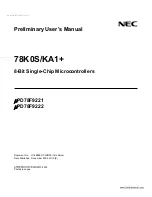LPC5411x
All information provided in this document is subject to legal disclaimers.
© NXP Semiconductors N.V. 2018. All rights reserved.
Product data sheet
Rev. 2.1 — 9 May 2018
34 of 105
NXP Semiconductors
LPC5411x
32-bit ARM Cortex-M4/M0+ microcontroller
7.16 General Purpose I/O (GPIO)
The LPC5411x provides two GPIO ports with a total of 48 GPIO pins.
Device pins that are not connected to a specific peripheral function are controlled by the
GPIO registers. Pins may be dynamically configured as inputs or outputs. Separate
registers allow setting or clearing any number of outputs simultaneously. The current level
of a port pin can be read back no matter what peripheral is selected for that pin.
See
for the default state on reset.
7.16.1 Features
•
Accelerated GPIO functions:
–
GPIO registers are located on the AHB so that the fastest possible I/O timing can
be achieved.
–
Mask registers allow treating sets of port bits as a group, leaving other bits
unchanged.
–
All GPIO registers are byte and half-word addressable.
–
Entire port value can be written in one instruction.
•
Bit-level set, clear, and toggle registers allow a single instruction set, clear or toggle of
any number of bits in one port.
•
Direction control of individual bits.
•
All I/O default to inputs after reset.
•
All GPIO pins can be selected to create an edge or level-sensitive GPIO interrupt
request.
•
One GPIO group interrupt can be triggered by a combination of any pin or pins.
7.17 Pin interrupt/pattern engine
The pin interrupt block configures up to eight pins from all digital pins for providing eight
external interrupts connected to the NVIC. The pattern match engine can be used in
conjunction with software to create complex state machines based on pin inputs. Any
digital pin, independent of the function selected through the switch matrix can be
configured through the SYSCON block as an input to the pin interrupt or pattern match
engine. The registers that control the pin interrupt or pattern match engine are located on
the I/O+ bus for fast single-cycle access.


















